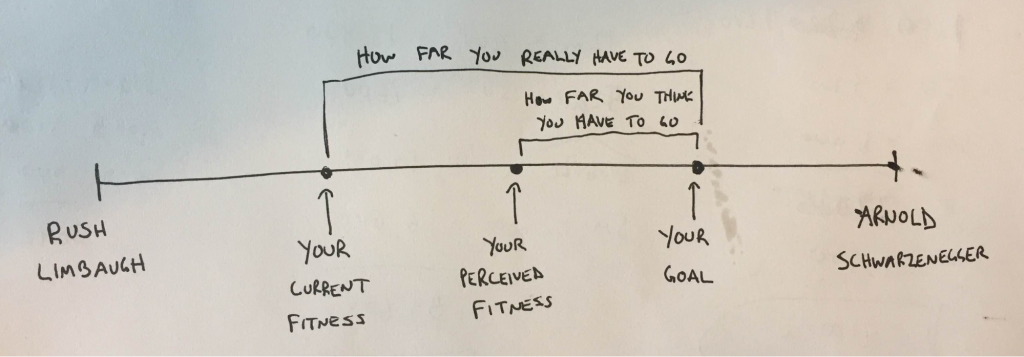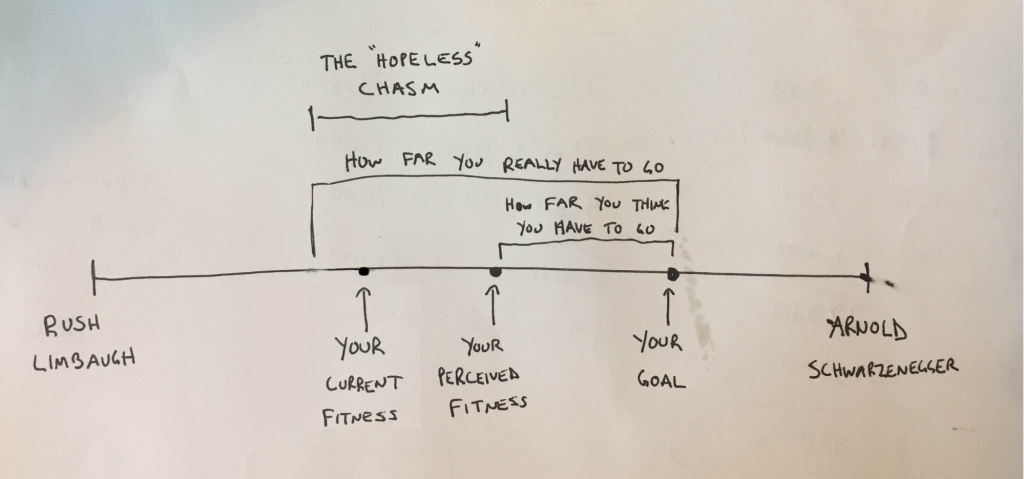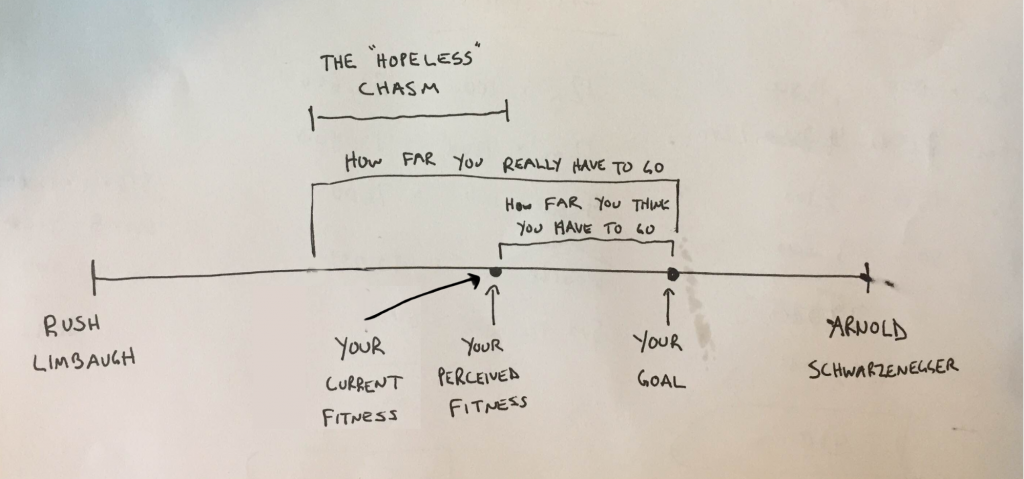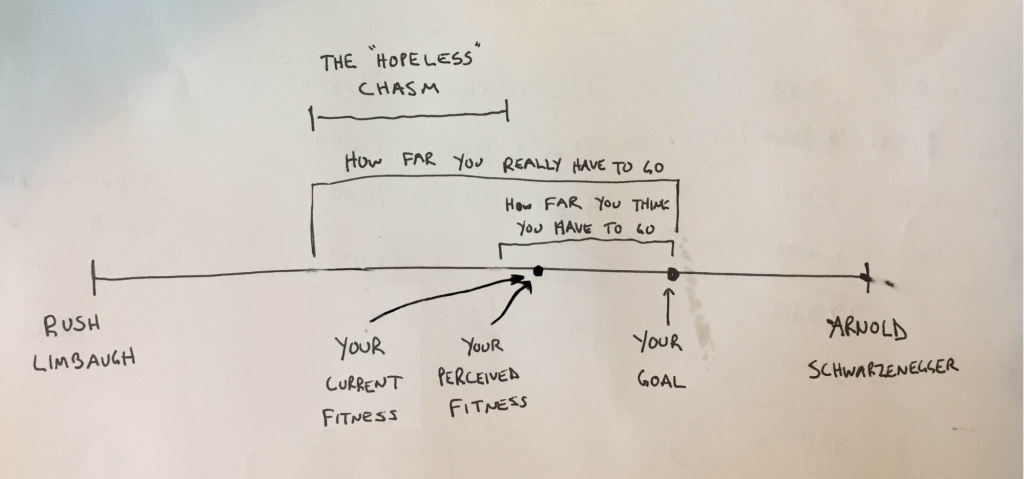
I looked around in embarrassment.
When I first got into fitness, I dreamed of going to the beach and getting the chance to show off my body to the hoards of admirers.
But here I was, 4 years into training and known as “the fitness guy” among my friends, and still horrified at the thought of taking my shirt off in public.
Maybe you can relate to this situation. Maybe you’re also living in the purgatory of small muscles, a little belly, and lack of muscular definition; that frustrating middle ground that can fool people into thinking you’re in good shape when you’re clothed, but cannot fool anyone when the shirt comes off.
There’s a name for that purgatory: skinny fat.
Although it sounds like an oxymoron, people who are skinny fat have very little lean muscle, high levels of body fat, but are skinny enough to look fit with a shirt on.
They aren’t in bad shape, but they certainly aren’t in good shape either. They don’t think of themselves as fat, but they always seem to be striving to be fitter and never getting there.
This article contains the skinny on being skinny fat. First, it explains the situation that skinny fat people face. Then it gets into exactly what you need to know to go from skinny fat to shredded, the stuff I wish someone had told me years ago when I kept my shirt on at the beach to maintain the illusion of fitness.
Why You’re Lucky to Be Skinny Fat
The first thing that skinny fat people need to do is take an honest assessment of their situation.
I’ve been skinny fat long enough to know all the classic excuses:
- “I work out but I don’t see any results.”
- “My body just doesn’t get rid of those last couple pounds of fat.”
- “I’m a hardgainer. It’s not easy for me to put on muscle.”
All of these are reasonable responses to the situation, but they are still excuses.
The real problem is that you’re in worse shape than you think.
You are lucky because your body is doing you a favor by covering up how bad the situation really is, and you’re responding by thinking you don’t have that far to go.
If you were extremely overweight, you’d understand that it wouldn’t just take 3 months of hard working out to become an Adonis. But, because your body does such a good job of tricking you into thinking you’re fit, you expect to see results quickly.
Let me explain with a diagram:

On the famous Limbaugh-Schwarzenegger scale, you actually fall somewhere towards the bottom end. But, because your body has this magical skinny fat property, it covers up your fatness pretty well.
Instead of showing your fatness, or your skinniness, they blend together to create a perception of reasonable fitness. You still have some work to do, but you’re not too far from your goals.

But that isn’t the reality. In truth, your current fitness is a long way away from your goal.

The Problem of Skinny Fat: The “Hopeless” Chasm
All the excuses we discussed above come from this core problem. Skinny fat people think they’re almost there, so they should see quick results. But, in reality, they have a long way to go.
- “I work out but I don’t see any results.” Yet!
- “My body just doesn’t get rid of those last couple pounds of fat.” It’s not just a couple pounds!
- “I’m a hardgainer. It’s not easy for me to put on muscle.” You have a lot of muscle to gain, and that takes time!
The challenge for people who are skinny fat is to cross what I call the “hopeless” chasm. The hopeless chasm is all the hard work and dedication it takes to get from your current fitness level to your perceived fitness level.

The issue that plagues skinny fat people is that this gap is huge. It can take months of dedicated effort just to have their real fitness reflect the way their body has looked all along.
This can be incredibly demoralizing.
Working out and eating well can be difficult even when seeing results, and skinny fat people don’t have the benefit of this immediate feedback. Their real fitness level is improving, but the changes don’t have a huge impact on their visible shape.

Their real fitness level is moving along the chart, slowly gaining ground on Arnold, but until they cross their perceived fitness level, the results are invisible.
This is true for fat loss, but it’s even more true for muscle gain. Lyle McDonald, in a post about genetic muscular potential, offers this breakdown of yearly gains:
- For the first year of training, you should gain 2 pounds of muscle per month
- For the second year of training, you should gain 1 pound of muscle per month
- For the third year of training, you should gain 0.5 pounds of muscle per month
- After the third year, you’re lucky to gain 2-3 pounds of muscle per year
Even with the fast start, gaining 2 pounds of muscle per month isn’t much. It’s a slow and steady process, and it takes time to see results.
The Skinny Fat Breakthrough
One day in every ex-skinny fat person’s journey, something amazing happens.
They wake up one morning and look in the mirror, and they look physically different. They can see the definition in their shoulders, or the beginnings of a six pack.
This day isn’t magical. They didn’t become fit overnight. What happened is that finally, after months of hard work, their real fitness level crossed their perceived fitness level.

Now that their perceived fitness level and real fitness level are on par, their fitness gains are finally reflected in the real world. They’ve closed the gap.
In a sense, the real fitness level has “picked up” the perceived fitness level, and is carrying it towards the goal.

At this point, you’ve escaped from the hopeless chasm. You still have plenty of hard work ahead of you, but you’ll be able to see the results of your work.
For most skinny fat people, this is the point of no return. Now that they can finally see the impact of their healthy lifestyle, it becomes easy.
And, finally, they’re proud to take their shirt off at the beach.
When I explain this concept to most people, they have the same response: That’s great Jay, but what do I do? Should I focus on losing weight? Putting on muscle?
The answer is both. Now that you understand the fundamental challenge facing skinny fat people, I’ll discuss what exactly you should do to get through the hopeless chasm and on the path to reaching your fitness goals.
Why Weight Loss Alone Isn’t Enough To Cure Skinny Fat
Being skinny fat is a body composition issue, not a weight issue. The number on that scale, while not insignificant, is simply another data point.
Your main concern is how much lean muscle you have versus how much body fat your body is composed of.
Think about your body fat percentage now. What would you estimate it to be?
Here’s why your guess is probably wrong:
- The average person will underestimate their body fat percentage by 8-10%, if not more.
- If you don’t exercise at all, your level of body fat is almost certainly 20% or higher.
- If you exercise every now and then, you’re probably between 15 and 20%.
- Very few people—mainly extreme ectomorphs—have ever seen single digit body fat without being on a strict diet and exercise program.
Most people struggle with high levels of body fat, which is why I encourage everyone to lose body fat first regardless of their body type or fitness goals.
If you just stop eating, you’ll lose muscle and fat, and end up with the same body composition. Let me say this another way:
If you lose weight without gaining or maintaining your muscle, you’re still going to be skinny fat.
Many people are slow to adapt this mindset shift. We’ve been programmed to think that a lower body weight means we’ll look better than we do now.
That is true—you will look better—but you won’t look your best.
Why Gaining Muscle Alone Also Isn’t Enough To Cure Skinny Fat
The cousin to skinny fat is “fat jacked.” Rather than explain it, take a look at this prime example:

You can see it, right?
I worked out and looked buff with my shirt on. At 183 pounds, I was bulked up.
But when the shirt came off, there was zero definition because I had over 20% body fat.
If you have a decent amount of lean muscle, a general rule of thumb concerning body fat and muscle gain is this:
- You can have up to 15% body fat and still look ripped.
- If you have more than 15% body fat, you’re fat jacked.
The leaner you are, the more definition you’ll have as you add muscle.
I’ll prove it to you. Here I am at 8% body fat and 153 pounds:

Losing 30 pounds and cutting my body fat by 12% highlighted my muscular definition like never before. I wasn’t fat jacked anymore—I was just jacked.
If you’re serious about adding muscle, you’ll see the best results if you shed fat before bulking up because human beings always look better leaner:
- If you’re a guy, get down to 10% body fat before adding muscle.
- If you’re a girl, get down to 20% body fat before adding muscle.
Getting down to that baseline allows you to track the tiniest gains and start seeing encouraging physical changes early in the process, like getting definition in your lower abs.
If you’re a girl, don’t worry about getting “bulky.” I hear this all the time and it’s a misnomer.
How to Stop Being Skinny Fat
Before you think about cutting body fat or adding muscle, you need to take a hard look at your eating habits and develop a diet that fuels your success rather than sabotages it.
The formula for proper fitness is 85% diet and 15% exercise.
No amount of time in the gym will solve skinny fat unless your diet is on point.
The diet that I advocate in Hack Your Fitness has four components:
- Counting Calories: Set a calorie budget for workout and non-workout days.
- Tracking Macros: Make sure you’re getting the proper levels of protein, carbs, and fat.
- Intermittent Fasting: I fast from 8 pm to noon the next day, which allows me to work out in a fasted state and absolutely torch body fat.
- No Alcohol: This one sucks, but it’s not all bad news.
The next step is to get your ass in the gym at least three days a week to start burning body fat. That’s the first step on the exercise side whether you want to add muscle or not.
The most efficient way to burn body fat is through compound lifts.
I recommend dedicating each of your workouts to one of the three main lifts:
- First workout of the week: Squat (leg day)
- Second workout of the week: Bench Press (push day)
- Third workout of the week: Deadlift (pull day)
These are the minimum lifts you should do each day. You can add in secondary lifts if you want, but don’t overdo it.
The full workout plan that I recommend is contained in my guide, which you can download here.
The Fight Against Skinny Fat Never Ends
Losing your skinny fat bod is a physical challenge. Keeping it gone is a psychological challenge.
Your ability to shed the skinny fat label for good comes down to you acknowledging and accepting this fundamental truth:
Your new diet and exercise programs are lifestyle changes, not temporary solutions that you can drop once you get the results you want.
Achieving and maintaining new muscle gains is a lifelong endeavor.
Even if you’re not trying to be a professional bodybuilder, muscle growth requires patience and persistent as consistent gains slow down year after year.
On the diet side, going back to the way you ate before you started eating clean is the fastest way to bring back your skinny fat body.
The way you eat when you’re trying to burn fat is the way you’ll eat the rest of your life if you want to maintain your results.
No one said it would be easy but if you need some extra motivation on those days when you walk around the beach thinking to yourself, “Being skinny fat isn’t that bad,” I want you to remember this quote by the Governator:
“A well built physique is a status symbol. It reflects you worked hard for it, no money can buy it. You cannot borrow it, you cannot inherit it, you cannot steal it. You cannot hold onto it without constant work. It shows discipline, it shows self respect, it shows patience, work ethic and passion. That is why I do what I do.” – Arnold Schwarzenegger
